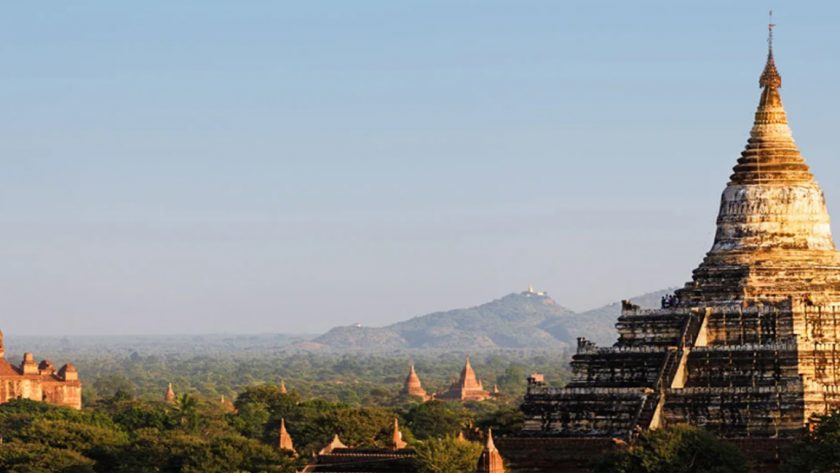“Say, Kyaw,” I asked our guide, “do you believe in nats?”?
“Not very much,” he said. We were standing in the shade of a sprawling banyan tree near Taung To village market on the banks of Inle Lake, Myanmar (formerly known as Burma). Kyaw stood out from the villagers in his city-made, stiff-collared white shirt, purple plaid Burmese sarong, worn by men and women – and rakishly tilted “country” straw hat. Next to us stood a dollhouse-size shrine perched on stilts, a common sight. Big trees, particularly banyans, are considered by the Burmese to be popular homes for the animistic spirits they call the nat. This tree’s tenant, however, wasn’t satisfied with Kyaw’s answer: a fruit dropped from the overhanging branch and hit him on the shoulder. “But not very little, either,”? he added hastily.
I spent three weeks speaking with locals, read the surprisingly few books available on the subject, and from what I can ascertain, the nats are what you get when you cross a saint and a poltergeist and throw in a bit of Greek god for good measure. Some are good, some evil, but many mix in a bit of both. Most were historic figures who died tragic deaths, but some were never alive in the first place. The Burmese recognize a shifting pantheon of 36 major nats and an infinite array of minor ones. They even have their own Mount Olympus: Mount Popa, an extinct volcano that is home to the ruling brother and sister Mahagiri nats.
Buddhists may be the majority in Myanmar, and the devout claim that they have no fear or need of the nats, but most will make an offering when they really want something. Kyaw and his wife, for instance, have been trying for a child for years, and on more than one occasion during temple visits I noticed him slipping away to make offerings to the fertility nat. In the rural areas, nat-worship is much more prominent. on an overnight trek through the Shan State’s alpine farmland, we passed through the Pa-O village of Zadi Gone where a booming market for ginger – the town’s primary source of income – had set off a flurry of building in the dusty streets. At every site where villagers were sawing bamboo, weaving rattan walls, and thatching palm-leaf roofs, they had erected poles and hung from them unripe bananas, a green coconut, and the red-and-white cloth that symbolizes homage to the nats. Our trekking guide, Paul Andrews, explained to us that every building has its own nat, and without these housewarming gifts the laborers will be too afraid of nat-driven “accidents” to get anything done. That’s a protection racket that would have made John Gotti jealous.
In contrast with Zadi Gone’s timeless rattan-and-thatch motif (popular since the single-digit centuries), the nat shrine on the edge of town was a modern cement-and-tin marvel, the eaves adorned with the curlicue antefixes that feature prominently in the Buddhist aesthetic. The Pa-O had built the shrine a safe distance from the village and kept it in good condition because they wanted the nats to stay happy, at home, and out of mischief. Inside, it looked quite snug, with fresh frangipani blossoms, a small bed, even an electric light. Makes sense – if I were a saucy spirit, I’d be much less likely to terrorize the villagers on those windy evenings if I had the option of curling up with the Burmese equivalent of a John Grisham.
Of course, that’s assuming that the light will actually work; electricity is after all a luxury in Myanmar. In Yangon (Rangoon), the capital, middle-class neighborhoods are lucky to get six good hours of juice, the rich neighborhoods get 24, and everyone who can afford to owns a generator. Myanmar is a country whose infrastructure hasn’t reached the 18th century, let alone the 21st, but the nats, happily, compensate, subbing in for many of our modern institutions. For instance, it is not unheard of for a nat to possess some unsuspecting soul and encourage him to remove beef, which is offensive to the nats, from his diet – or else. Who needs Weight Watchers when you’ve got Dr. Natkins supervising your meals?
On our trek, Paul entertained us with his experience of the “nat-Lojack” system. An ethnic Tamil Indian and a devout Catholic, Paul didn’t used to believe in the nats. Then, a month before he took us trekking, he couldn’t find a $100 bill and feared it stolen. He went to see a famous Buddhist monk, who communed with the local nats and told Paul that the money was still in his bedroom. Paul went home and found the bill under his mattress where he had hidden it. If the money had been stolen, he later found out, the monk would have tapped into the network of local and house nats to find the thief’s personal nat, who would have pressured the thief to return the money. That’s a heck of a lot less paperwork than a police report.
The quirky relationship between Buddhism and the nats can be traced back to the 11th century A.D., when the great King Anawrahta united Myanmar for the first time. He introduced Buddhism and tried to eradicate the nat cult, but settled for introducing Thagyamin – a Hindu deity who had historically paid homage to Buddha – as the 37th nat and new overlord of the original 36. This effectively subjugated the nat cult to Buddhism and outlawed rituals like animal sacrifice, but nat-worship remained alive and well. As Kyaw told me, “Buddhism is for this life and the next, but the nats are only here for this life.”?
Nowhere are the nats more “for this life” than at the nat festivals that occur around Myanmar several times a year. In a country of conservative mores, nat festivals are for some a necessary release. nat-worshipers and nat-kadaw – nat priests who are either women or transvestites – convene at these animistic Woodstocks for a week or more of wild music, drinking, dancing, and spirit possession. Some possessions are invited by nat-kadaw during ceremonies (playful nats occasionally inhabit spectators instead), but others are inflicted by nats displeased with those breaking the Buddhist precept forbidding alcohol. I can just picture a husband trailing his humiliated wife home from a festival, pleading, “It wasn’t me, I swear! It was the nat”?
I was lucky enough to actually witness one of these possessions. Visiting the ancient Shwezigon Pagoda in Bagan, we found a group of women kneeling before King Anawrahta’s now-decrepit shrine to the 37 nats, an array of surprisingly human-looking, white-skinned figures behind a dirty plexiglass pane. Through Kyaw, I found out that one of the women had just won a $1,000 lottery, which explained the plethora of coconuts, bananas, and orange soda (the nats favorite, natch) arrayed before the idols. She still wasn’t satisfied, however, and had set her sights on owning the BMW of Burmese status symbols – a land-line phone – which, due to the government monopoly and poor infrastructure, sells for $3,500. She claimed a nat had given her the winning number in a dream, so she had hired a nat-kadaw to commune with the same nat to help her make up the difference.
The gambler-friendly nat in question was the Valiant Lord Kyawswa, a very popular figure with the men. Kyawswa, or Big Brother Joe as he is affectionately known, loves fireworks, fighting, and especially drinking. At nat festivals, he swaggers on onstage carrying a bottle of rum and passing out drinks to the hoots and hollers of the guys in the audience. His version of a tragic death came from a little too much of his father-in-law’s toddy-wine; unsurprisingly, he is the patron nat of rogues and vagabonds.
When he visited Shwezigon that day, however, Big Brother Joe (or the old woman he’d taken possession of) had to be content with smoking two cigarettes at a time since his preferred rum would be disrespectful to Buddha. For the first few minutes, he danced spasmodically – probably because he wasn’t used to the old woman’s frame – to the fitful jack-in-a-box music playing on the radio and ignored the questions directed at him. All of a sudden, he grew angry and began lecturing the women about his shrine’s state of disrepair. If they really wanted more wealth, he said, they first needed to spruce up his shrine and make more regular offerings. Oh, and they should give him a shawl at the upcoming Popa nat festival since he was a little chilly at night. He swigged an orange soda, threw a bowl of triangularly folded money backward over his head, and departed, leaving the nat-kadaw shivering in his wake – completely unaware of what had transpired. I wasn’t, though; I tucked away a stray bill that had landed in my shoe – nat-money is good luck.
By the time we returned to Yangon we were converts. I was sticking small bills in the hands of nat figures wherever I found them. My traveling companion was worrying about her malaria medication and chugging water frequently “as an offering to the Mefloquine nat.” Kyaw accompanied me to a woodcarver, whom I commissioned to make teakwood nat figurines for myself and my friends, and he sat with me for an hour translating my haggling. At the end, I thanked Kyaw for his patience, and he said, “No, no, thank you. The nat will do me many favors for helping you bring them to America.” Watch out, Las Vegas – here comes Big Brother Joe!




how to buy enclomiphene generic low price
buying enclomiphene australia pharmacy
kamagra prescription en ligne singapour
acheter kamagra generique
purchase androxal australia online generic
how to order androxal generic buy online
order flexeril cyclobenzaprine new york city
buying flexeril cyclobenzaprine purchase online from india
how to order dutasteride australia to buy
cheapest buy dutasteride price from cvs
cheapest buy gabapentin generic work
order gabapentin cheap australia
order fildena uk order
cheap fildena no prescription online
is itraconazole over the counter in the USA
itraconazole american express canada
canadian staxyn with no prescription
buying staxyn buy in london
cheapest buy avodart canada generic
buy avodart tablets australia
buy rifaximin uk order
rifaximin perscription from s online
discount xifaxan uk sales
buying xifaxan canada medicine
nejlevnější usa kamagra
koupit kamagra a cealis online z kanady